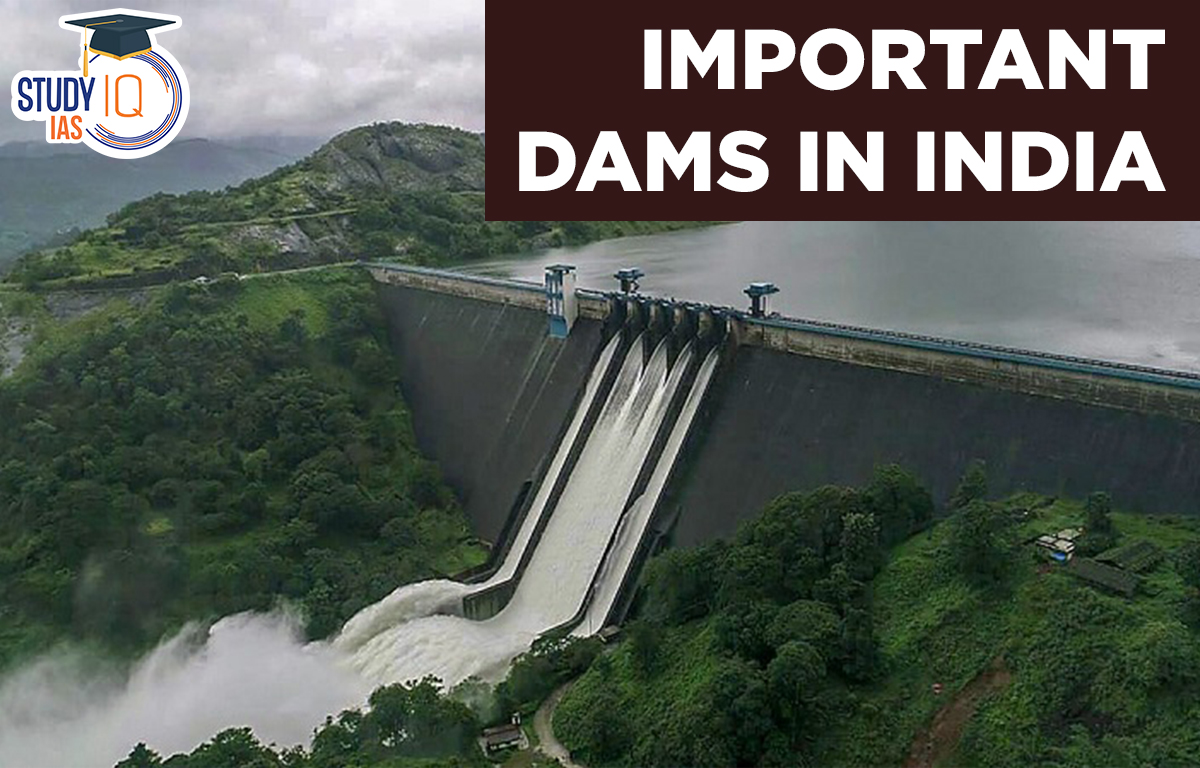Table of Contents
Dams play a crucial role in India’s water management, agriculture, and hydroelectric power generation. As one of the largest countries in the world, India boasts a diverse array of dams that serve multiple purposes, including irrigation, flood control, and energy production. This article provides a comprehensive overview of the longest, highest, and oldest dams in India, highlighting their significance and contributions to the nation’s development.
Important Dams of India
Dams have played an important role in India’s development by providing water for farming, generating clean hydroelectric power, and controlling floods. India has 5334 dams with 447 being very important. Dams are built across rivers or streams to hold back water. They help store water, control floods, and generate energy. Dams create reservoirs that supply water for irrigation, flood control, fish farming, drinking, and navigation. A dam is an artificial barrier made to hold water, and the reservoir it creates is used for irrigation, power generation, and more. Dams are classified based on their structure and purpose.
Top 5 Major Dams in India
1. Tehri Dam
Tehri Dam is located in Uttarakhand on the Bhagirathi River. Its 260.5-meter height makes it India’s tallest dam, and it ranks among the 10 highest dams in the world.
| Tehri Dam | |
| Height of the Dam | 260.5 m |
| Length of the Dam | 575 m |
| Type of Dam | Rock fill |
| The reservoir capacity | 2100000 acre feet |
| Capacity that is installed | 1000 Megawatt |
2. Bhakra Nangal Dam
The Bhakra Nangal Dam is situated on the Sutlej River in the states of Himachal Pradesh and Punjab. It is the largest dam in India, with a height of 225 metres, and is also the second-largest dam in Asia.
3. Hirakud Dam
The Hirakud Dam is located in the Odisha state on the River Mahanadi. With a total length of 25.79 km, it is the longest dam in India and among the top ten longest dams in the world.
| Hirakud Dam | |
| Height of the Dam | 61 m |
| Length of the Dam | 4.8 km (Main Dam) |
| Type of Dam | Composite Dam |
| The reservoir capacity | 47,79,965 acre feet |
| Capacity that is installed | 347.5 Megawatt |
4. Nagarjuna Sagar Dam
The Nagarjuna Sagar Dam is in the Telangana state, along the Krishna River. It is the largest masonry dam ever constructed in India and the world’s largest artificial lake. It is 1.55 kilometres long and has 26 gates.
| Nagarjuna Sagar Dam | |
| Height of the Dam | 124m |
| Length of the Dam | 4863 m (Total Lenght) |
| Type of Dam | Masonry Dam |
| The reservoir capacity | 93,71,845 acre feet |
| Capacity that is installed | 816 Megawatt |
5. Sardar Sarovar Dam
The Sardar Sarovar Dam is in Gujarat, on the Narmada River. It is the biggest dam in the Narmada Valley Project. The nearby states of Madhya Pradesh, Rajasthan, and Maharashtra benefit from this dam.
| Sardar Sarovar Dam | |
| Height of the Dam | 163m |
| Length of the Dam | 1210m |
| Type of Dam | Gravity Dam |
| The reservoir capacity | 77,00,000 acre-feet |
| Capacity that is installed | 1450 Megawatt |
Check out the linked article on the UPSC Syllabus 2024 Here!
State-wise Dams in India
List of Dams in India with River and State:
| Name of Dams | State | River Name |
| Somasila Dam | Andhra Pradesh | Pennar River |
| Srisailam Dam | Krishna River | |
| Ukai Dam | Gujarat | Tapti River |
| Dharoi Dam | Sabarmati River | |
| Kadana dam | Mahi River | |
| Dantiwada Dam | Banas River | |
| Bhakra Nangal Dam | Himachal Pradesh and Punjab Border | Sutlej River |
| Pandoh Dam | Himachal Pradesh | Beas River |
| Nathpa Jhakri Dam | Satluj River | |
| Chamera Dam | Ravi River | |
| Baglihar Dam | Jammu and Kashmir | Chenab River |
| Dumkhar Hydroelectric Dam | Indus River | |
| Uri Hydroelectric Dam | Jhelum River | |
| Maithon Dam | Jharkhand | Barakar River |
| Chandil Dam | Swarnarekha River | |
| Panchet Dam | Damodar River | |
| Tunga Bhadra Dam | Karnataka | Tungabhadra River |
| Linganamakki dam | Sharavathi River | |
| Kadra Dam | Kalinadi River | |
| Alamatti Dam | Krishna River | |
| Supa Dam | Kalinadi or Kali river | |
| Krishna Raja Sagara Dam | Kaveri River | |
| Harangi Dam | Harangi River | |
| Narayanpur Dam | Krishna River | |
| Kodasalli Dam | Kali River | |
| Malampuzha Dam | Kerala | Malampuzha River |
| Peechi Dam | Manali River | |
| Idukki Dam | Periyar River | |
| Kundala Dam | Kundala Lake | |
| Parambikulam Dam | Parambikulam River | |
| Walayar Dam | Walayar River | |
| Mullaperiyar Dam | Periyar River | |
| Neyyar Dam | Neyyar River | |
| Rajghat Dam | Uttar Pradesh and Madhya Pradesh Border | Betwa River |
| Barna Dam | Madhya Pradesh | Barna River |
| Bargi Dam | Narmada River | |
| Bansagar Dam | Sone River | |
| Gandhi Sagar Dam | Chambal River | |
| Yeldari Dam | Maharashtra | Purna river |
| Ujani Dam | Bhima River | |
| Pawna Dam | Maval River | |
| Mulshi Dam | Mula River | |
| Koyna Dam | Koyna River | |
| Jayakwadi Dam | Godavari River | |
| Bhatsa Dam | Bhatsa river | |
| Wilson Dam | Pravara River | |
| Tansa Dam | Tansa river | |
| Panshet Dam | Ambi River | |
| Mula Dam | Mula river | |
| Kolkewadi Dam | Vashishti River | |
| Girna Dam | Girana river | |
| Vaitarna Dam | Vaitarna river | |
| Khadakwasla Dam | Mutha River | |
| Gangapur Dam | Godavari river | |
| Singur dam | Telangana | Manjira River |
| Radhanagari Dam | Bhogawati River | |
| Lower Manair Dam | Manair River | |
| Mid Manair Dam | Manair River and SRSP Flood Flow Canal | |
| Upper Manair Dam | Manair River and Kudlair River | |
| Nizam Sagar Dam | Manjira River | |
| Jalaput Dam | Andhra Pradesh and Odisha Border | Machkund River |
| Indravati Dam | Odisha | Indravati River |
| Hirakud Dam | Mahanadi River | |
| Vaigai Dam | Tamil Nadu | Vaigai River |
| Perunchani Dam | Paralayar River | |
| Mettur Dam | Kaveri River | |
| Govind Ballabh Pant Sagar Dam / Rihand dam | Uttar Pradesh | Rihand River |
| Tehri Dam | Uttarakhand | Bhagirathi River |
| Dhauli Ganga Dam | Dhauli Ganga River |
Check out the linked article on the UPSC Prelims Syllabus 2024 Here!
List of Important Dams in India
Here is a complete List of Important Dams in India
| Name of Dam | State | River |
| Bhavani Sagar dam | Tamil Nadu | Bhavani |
| Tungabhadra Dam | Karnataka | Tungabhadra |
| Rihand Dam | Uttar Pradesh | Rihand |
| Maithon Dam | Jharkhand | Barakar |
| Koyna Dam | Maharashtra | Koyna |
| Bisalpur Dam | Rajasthan | Banas |
| Mettur Dam | Tamil Nadu | Kaveri |
| Krishnarajasagar Dam | Karnataka | Kaveri |
| Indira Sagar Dam | Madhya Pradesh | Narmada |
| Cheruthoni Dam | Kerala | Cheruthoni |
| Sardar Sarovar Dam | Gujarat | Narmada |
| Nagarjuna Sagar Dam | Telangana | Krishna |
| Hirakud dam | Odisha | Mahanadi |
| Bhakra Nangal Dam | Punjab-Himachal Pradesh Border | Sutlej |
| Tehri Dam | Uttarakhand | Bhagirathi |
Major Dams in India
|
Major Dams in India |
||
| Highest Dam in India | Tehri Dam(Uttarakhand) | Height: 260.5 meters Length: 575 meters River: Bhagirathi River Location: Uttarakhand Year of completion:2006 (1st phase) |
| Longest Dam in India | Hirakud Dam (Odisha) | Total Length: 25.79 km (16.03 mi) Length of Main Dam:4.8 km (3.0 mi) River: Mahanadi Location: Odisha Year of completion:1953 |
| Oldest Dam in India | Kallanai Dam(Tamil Nadu) | River: Kaveri Location: Tamil Nadu Year of completion: 100 BC –100 AD |
Longest Dam in India
The longest Dam in India is the Hirakud Dam. The Hirakud Dam is built on the Mahanadi River in the Sambalpur district of Odisha. The Hirakud Dam is 25.79 km long. It was completed in 1953.
Tallest Dam in India
The Tehri Dam is the tallest dam in India and the 12th tallest dam in the world, standing at 260.5 meters high. It is located on the Bhagirathi River in the town of New Tehri, Uttarakhand. The dam is 575 meters long and 260 meters high. The dam’s reservoir has a total installed capacity of 1000 megawatts making it a significant source of renewable energy for the region. The first part of the dam was completed in 2006. It is an important part of the Tehri hydropower project managed by THDC India Ltd.
Oldest Dam in India
The oldest dam in India is the Kallanai Dam which is on the Kaveri River in the Thanjavur district of Tamil Nadu. It was built between 100 BC and 100 AD, and today, it is managed by the Tamil Nadu government.
Benefits of Dams
- Irrigation: Dams provide a reliable source of water for irrigation, ensuring agricultural prosperity and food security.
- Hydroelectricity: Dams generate clean hydroelectric power reducing dependence on fossil fuels and combating climate change.
- Flood control: Dams regulate river flows preventing devastating floods and protecting communities.
- Drinking water: Some dams supply drinking water to cities and towns.
Significance of Dams in India
Dams in India serve multiple purposes:
- Irrigation: Dams play a vital role in irrigation, especially in agriculture-dominated states. They provide a reliable water source, facilitating the cultivation of various crops and enhancing food security.
- Hydroelectric Power: Many dams generate hydroelectric power, contributing to the national grid and reducing dependence on fossil fuels. Hydroelectric projects help combat climate change by providing clean energy.
- Flood Control: Dams regulate river flow, minimizing the risk of flooding in downstream areas during heavy rainfall.
- Water Supply: Dams ensure a steady supply of drinking water to urban and rural populations, improving public health and sanitation.
Challenges and Concerns
- Displacement and Rehabilitation: The construction of dams leads to the displacement of communities, their livelihood and resettlement.
- Environmental Impact: Dams can harm ecosystems, biodiversity, and river communities.
- Siltation: Silt buildup in reservoirs reduces storage capacity and dam efficiency.
- Social and Economic Inequality: The benefits of dams may not be shared equally.
Conclusion
India’s dams are not only engineering marvels but also lifelines for millions of people. They contribute significantly to the country’s agricultural productivity, energy generation, and water management. Understanding the importance of these structures can help in formulating policies for sustainable development and effective resource management in the face of climate change and increasing water scarcity. The historical, cultural, and economic significance of dams underscores the need for continuous investment in infrastructure to support India’s growing population and economy.


 Indian Council for Agricultural Research...
Indian Council for Agricultural Research...
 Districts of MP List, Name, Importance, ...
Districts of MP List, Name, Importance, ...
 List of Awards and Honours Received by N...
List of Awards and Honours Received by N...





















